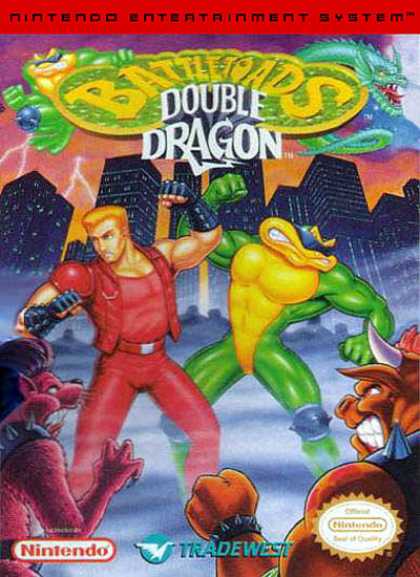Overview
 Battletoads & Double Dragon is an early example of a video game crossover.
Battletoads & Double Dragon is an early example of a video game crossover.In general, a crossover is any media that combines characters, events, and other elements from two or more separate media sources. In video games, such crossovers commonly take the form of games crafted specifically for the purpose of showcasing the characters involved. The earliest known example is the 1988 football/soccer game Battle Soccer, which brought together characters from Godzilla, Ultraman, Gundam, and Kamen Rider. Another early example is the 1993 brawler Battletoads & Double Dragon: The Ultimate Team, which partnered characters from Rare's Battletoads series and Technos Japan's Double Dragon series together.
In more recent years, the most prominent crossovers have typically appeared in the fighting game genre. The most well known crossover fighters have been produced most frequently with the involvement of Capcom, collectively known as the Vs. Capcom series. The company has developed and published numerous crossover titles over the years in partnership with non-video game companies such as Marvel Comics and Tatsunoko Production in addition to fellow game publishers such as SNK, who in turn produced their own crossover titles with Capcom characters. The most recent crossover deal is with Namco, who will make the game Tekken X Street Fighter, Capcom themselves having made Street Fighter X Tekken.
In addition to crossovers between properties belonging to separate companies, individual publishers sometimes produce crossovers of their own properties. The first major crossover of this kind was the 1996 Saturn game Fighters Megamix, which combined characters from several Sega franchises, including Virtua Fighter, Fighting Vipers, Virtua Cop, and Sonic. However, some of the most famous examples are Nintendo's Super Smash Bros. games, which feature characters, stages, and other elements from throughout their extensive back catalogue of diverse properties ranging from Super Mario Bros. to Fire Emblem to Ice Climber.
Still other crossovers may star no prominent video game characters at all. Banpresto's long-running Super Robot Taisen series features casts of characters pulled from a wide range of super robot-themed anime and manga. Due to the number of licenses involved, none of the primary games in the series have ever seen officially localized versions released outside of Japan, though titles from the franchise's "OG" subseries that removes the crossover element in favor of entirely original characters have seen international release.
One final notable example of a crossover is Kingdom Hearts, which combines characters from Square Enix's Final Fantasy series with the characters and worlds of various Disney movie properties and casts players in the roles of all-new, original characters. What began as a novelty in Final Fantasy and Disney coming together has evolved into its own series, with an extensive list of original characters and an ongoing story arc atypical of most crossovers.
Other Examples
Samurai Warriors 3
Koei's third main entry in the Samurai Warriors series was produced in conjunction with Nintendo. The game features Murasame Castle mode; a challenge mode inspired by an old Famicom Disk System game, Nazo no Murasamejou. In this mode, the player may play as the Famicom game's protagonist Takamaru.
Poker Night at the Inventory
Telltale Games' Poker Night at the Inventory is at its heart a simple poker title. However, the player's opponents are the Heavy from Valve's Team Fortress 2, Max from Lucasarts and Telltale's Sam & Max series, Strong Bad from the Homestar Runner website and his own episodic Telltale game series, and Tycho Brahe, one of the two leads of the popular Penny Arcade webcomic. The characters banter about their various misadventures during play, adding color to the game's otherwise simple design.
Super Meat Boy
The indie title Super Meat Boy from Team Meat features numerous unlockable characters that the player can alternatively choose to play as, each with their own special techniques. Many of these characters were borrowed from other developers of downloadable indie games. Characters that appear in the game include Commander Video of Gaijin Games' Bit.Trip series, The Kid from the masocore title I Wanna Be The Guy, Tim from Jonathan Blow's Braid, and numerous others.
Asura's Wrath
Two downloadable episodes due for release on May 9th and May 16th, 2012 for the Capcom game Asura's Wrath will feature Asura battling Ryu and Akuma from Capcom's Street Fighter series.
Log in to comment